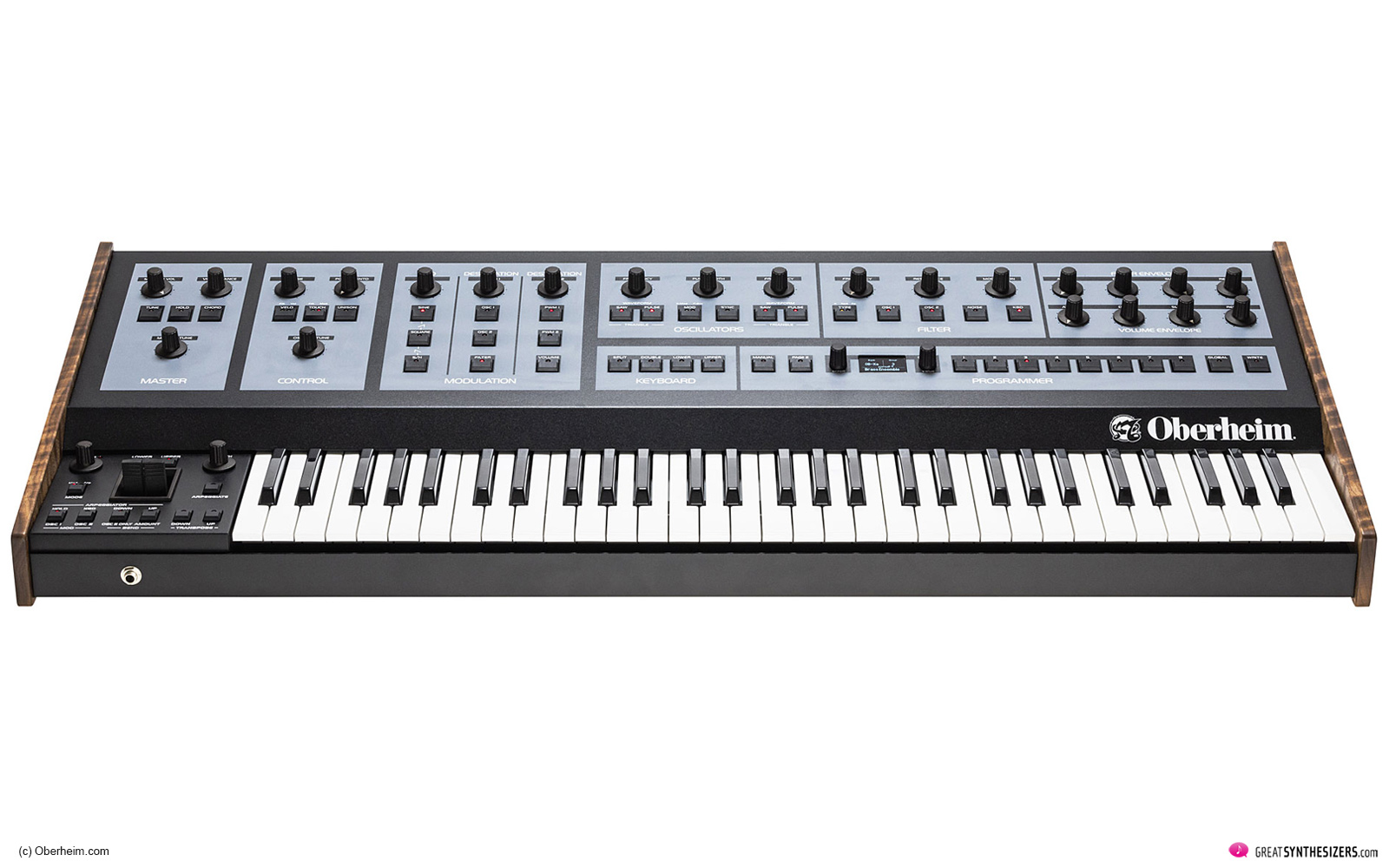Text: Matt Vrazo, Music: Stephane Garganigo (Barb)
I’m a big Oberheim fan! At some point I’ve owned everything put out by the original incarnation of that brand (or at least a variation of: the Four-Voice (FVS), not to mention several SEMs, covers both the Two-Voice (TVS) and Eight-Voice in my book). If really keeping tabs, the only one I’ve never even played is the Matrix-6, but I never felt like I was missing anything there.
So, it’s been with great joy that I’ve watched Oberheim, both the man and the company, return to making synths. Way back in 2009 I became the owner of Tom Oberheim SEM #1 (by accident, as it turns out — I got in early, but Tom forgot to mail it to me for months). I’ve since had a deposit on the never-to-be completed Son Of 4-Voice and owned the Tom Oberheim Two-Voice Pro, the OB-6 rack/keys, and not one, but two OB-X8 … that’s a lotta Oberheim!
My first experience with the OB-X8 started off great. I ran some extensive A/B comparisons with the lovely OB-8 I also had. The OB-8 was at that time my favorite Oberheim but the OB-X8’s similarities (and improvements) far outweighed any tonal differences to the point where I felt good about selling the OB-8.
But then things went downhill. The OB-X8’s paddles started rubbing against something internally and had to be replaced. I then noticed some voice volume discrepancies between the main (lower) and expansion (upper) voice boards. Focusrite/Oberheim did their best to resolve but at the time they were painting it as a hardware issue and no amount of replacement boards could fix it. The volume thing was one of those issues that felt inexcusable on such a high-end synthesizer from a mainstream company; it was also one of those issues that once you hear you can’t unhear. And so rather than fret about it every time I turned it on, I returned it and went back to waiting for the Abstrakt VS-1. (I’m still waiting, FYI.)
Thankfully it seems I was not the only one who noticed the volume discrepancy and so no less than 4 months later they released a software update that fixed this issue. At that point it was only a matter of time before I returned to it and that time is now.
With no hardware or technical issues encumbering my experience, I feel like I’ve been able to go through the “new synth” experience with the OB-X8 all over again and this time it’s impressed me even more. To the point where I can now proclaim that the OB-X8 is the best Oberheim ever.
Exsqueezme? Baking powder? Best Oberheim ever?
Yep, and here’s a list of reasons why:
1) It sounds like a vintage Oberheim
Yeah, duh, but how? The Oberheim “sound” to me isn’t just the 2-pole filters, it’s a combination of filters, loose tuning, and less than HIFI oscillators. I talk about the filters below so here I’ll discuss the tuning and oscillator spectra.
Tuning: First, some background. When it comes to tuning on an analog synth, there isn’t one but three elements that contribute to what we like or loathe about analog synths: 1) chromatic tuning, 2) intra-oscillator variation, and 3) jitter.
First, there is simple chromatic tuning — a voice hitting the right notes across the keyboard. If it doesn’t, if it’s truly “drifting” out of tune, then this isn’t desirable no matter what kind of analog diehard you are. However, a small amount — a few cents up or down on each voice — can create a pleasing sound, and this was a big part of the Oberheim “brass” sound.
Then there is the variation within a voice, between the oscillators themselves. Most traditional polys have two oscillators per voice, which means there are two sound sources that are not always going to track the keyboard accurately or have identical pulsewidth shapes or start at the exact same phase relationship as the last voice played. Like with chromatic tuning, too much intra-voice variation will simply sound out of tune or dissonant, but small amounts create all sorts of pleasing phasing and movement, which is what most people are probably thinking about when they espouse the virtues of analog. This is another hallmark of the Oberheim sound.
Finally, there is jitter, which is a term co-opted from the digital word that describes the movement of the oscillator pitch itself as micro-oscillations or fluctuations. Excessive jitter (think the sound of electricity) would just sound like a wobbly oscillator (= not good), but small amounts along with the intra-oscillator variation above can lead to even more pleasant 3D-phasing or the “edge of the speaker” effect you’ll hear analog synth nerds (me) wax lyrical about.
x
Of these three tuning parameters, Oberheims actually don’t have much jitter, at least not in the post-SEM models. And while chromatic and intra-oscillator calibration got better with each successive model, it was always there right up to the Matrix-12. With the OB-X8’s “Vintage” knob you might be misled into thinking the late Dave Smith and Co. sucked all the remaining life out of its oscillators in pursuit of perfection (as they did on the OB-6). But as it turns out, they didn’t. Following one calibration after I updated the OS, I haven’t touched the autotune or Vintage knob at all and there is just the right amount of both chromatic and intra-voice variation to make this thing breathe just like any vintage machine. As soon as you turn on the 2nd oscillator from an Init patch, you are there. No further tweaking needed.
You can push the oscillators farther apart with the Detune knob, but there is already so much natural variation from voice to voice that 90% of the time it isn’t even needed. When you do, just a touch in either direction on the high-resolution knob allows you to widen the sound without really detuning, because the oscillators are all starting in slightly different positions, just like on any older OB. Trying to get something similar on an OB-6 on the other hand is almost impossible because the voices are much more closely constrained and the bipolar detune knob simply doesn’t have the same resolution — you go from unison to DETUNED in barely one increment.
Spectra: If everyone knows at least something about Oberheim’s “loose” tuning, very few seem to consciously know about the stuff actually being pumped out by the oscillators, even if it’s a big part of what we interpret as the “Oberheim” sound. The CEM3340 oscillators on the OB-Xa/OB-8 are not bright. In fact they are downright dull, with a steep roll-off starting around 10Khz. This isn’t anything to do with the chip itself; the CEM3340 has to be one of the brightest oscillators out there. Instead, it seems to be due to a capacitor in between the oscillators and filter that acts as a simple filter that rolls off a good amount of the high-end frequencies before it even hits the filter. And thus in the absence of these higher frequencies (which our ears are most sensitive to), the mid-range sounds more prominent, leading to the girthy brassy sound Oberheims are so well known for. I don’t think this was anything intentional in terms of sound design on the part of the OB engineers, but more likely a tweak to avoid overdriving the filters.
So how does the OB-X8 compare? The OB-X8’s oscillators are slightly brighter than the OB-8/OB-Xa. This could be because they used the “SEM/X” oscillator as their starting point instead of the CEM3340. I don’t have an original SEM or OB-X here to compare, but logically they are probably a bit brighter than the murky OB-Xa/OB-8. But then the OB-X8 still has a very steep exponential roll-off compared to, say, a Minimoog, and this makes it mid-focused, just a little less so than an OB-Xa or OB-8.
If anything, the slightly brighter oscillators on the OB-X8 work to emphasize the phasing between the oscillators because there’s more frequencies to work with. Saw + Pulse on both oscillators with PWM and slight detuning creates a massive phasing sound that brings tears to your eyes and would make you think there’s an external effect plugged in somewhere if you didn’t know any better.
2) It’s got all the filters: Multimode SEM and CEM3320
… together at last. And the better implemented version of the OB-CEM at that. I always thought the 4-pole on the OB-Xa was very dry/dull, whereas it always seemed much nicer on the OB-8. There are certainly enough subtle design differences for this to be a possibility and either way, the smooth, delicate 4-pole mode on the OB-X8 sounds great. As for the SEM/CEM 2-pole filters, obviously the SEM is the best, no? No. They are remarkably similar, with the only real difference being a slightly sharper resonant peak on the SEM. Markus Ryle himself noted how similar they sound. But it’s nice to have the choice all the same.
On the multimode side, there are only single versions of BP/HP/Notch, whereas its predecessor the Xpander/Matrix-12 had LP/HP/BP filter varieties out the wazoo. But quantity doesn’t always equal quality and the BP/HP flavors on the Xpander/Matrix-12 didn’t ever sound particularly great to me. They were rough around the edges and not very musical. The OB-X8’s versions of these filter modes, coming from the SEM/OB-X, are much sweeter. I’m also fine with just one version of each. After ~13 years of constant use I can’t say I really ever determined a suitable musical context for a 1-pole HPF over a 2-pole HPF. Also, here I will make a concession to the OB-6, which includes a sweepable LP>HP filter. It’s a bit of an omission from the OB-X8, but in the grand scheme of things it really doesn’t make much of a difference in terms the sounds you can and can’t make on the OB-X8.
x
Music: Stephane Garganigo
Oberheim OB-X8
Polyphonic Analog Synthesizer
8 Voices (16 VCOs)
Prices:
(10/2023)
Oberheim OB-X8: approx. 4,999 USD / 5,279 Euros
Oberheim OB-X8 Desktop: approx. 3,499 USD / 3,898 Euros
Website Manufacturer:
https://oberheim.com
Link / Comparison:
Oberheim OB-8 Review







